
Table of Contents
What is ‘Systems Thinking’ in Health?
- Systems thinking is a comprehensive way of looking at all the building blocks/components of health system together.
- Systems thinking is a holistic approach of looking at a system as a whole and not looking at the pieces.
- It is a way of looking at how all the components/building blocks of health system interact, react and respond over the long period of time, when they are functioning together in a certain manner to be a better system.
- It is a way of viewing health through the broader perspective.
- Components of the system when isolated act differently, so for the proper study they need to be studied while they are within the system. This is what Systems Thinking is.
- System thinking is the diagnostic tool for the in-depth assessment of the problems before acting on it.
- It contributes to an understanding of how ‘things stand together’ as a whole
Evolution of the Concept of ‘Systems Thinking’:
The concept of system thinking raised back in 1940s by Ludwig von Bertalanfyy. He postulated his general system theory in which he stated that systems continually interacted with their environment. Von Bertalanffy’s view, open systems exhibited a tendency toward order. His view concerning open systems along with the interest of other scientists led to the creation of the International Society for the Systems Sciences (ISSS) in 1954, giving birth to systems thinking as a discipline.
Further system thinking introduced the concept of loop. It represent the causal relation in loop which is (say) A affects B, B affects C so there lies the causal relation between A and C. Direct relation may not be seen between A and C but the loop is formed by C affecting A
People started realizing the limitation of the rationale planning in 1960s already. However, during the 1970s and 1980s, discontent with traditional systems thinking also developed. This resulted update in the frameworks and intervention methods of system thinking resulting change in systems thinking to what it is today.
In 1990 Peter Senge popularized systems thinking in his book The Fifth Discipline. This popularized system thinking and were included into business field, education and even in health. System thinking as the diagnostic tool is in almost every sector and field.
Skills of ‘Systems Thinking’:
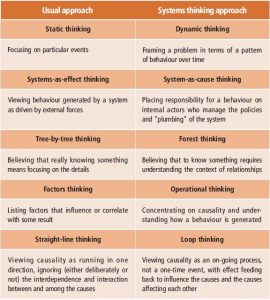
Need of ‘Systems Thinking’ in Health?
Systems Thinking is necessary because it will help to:
- Explore the problems in the health system from the systems perspective
- Identify solutions that work across sub-systems
- Promote dynamic networks of diverse stakeholders
- Inspire and encourage learning from each other
- Strengthen more system-wide planning, evaluation and research.
- To think holistically about the consequences and different stakeholders
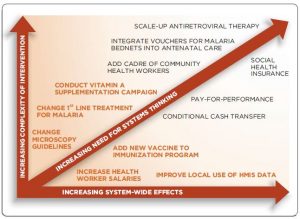
Additionally, Systems Thinking is also necessary because:
- Current implementation challenges in health system demand systems thinking.
- Lack of system understanding can give the shallow impression regarding the problems.
- Most of the time, problems in health system is only viewed from one dimension, completely missing the other dimensions of the system.
- All the components/building blocks of health system have a different role and dynamics with each other. So, none of them can be seen alone or left out.
- Any change in one components/building blocks of the system will have effect on the other components.
- No components/building blocks of health system can work alone efficiently, leaving the other components/blocks behind.
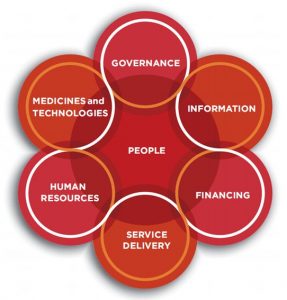
- There’s a relation between all the building blocks. If we target one building block, it will affect the other building blocks. So, all building blocks should be targeted together.
- A health system can only function efficiently through systems thinking approach.
- Need of change from linear thinking to broader thinking for delivering efficient health system
Applications of ‘Systems Thinking’ in Health Care:
1. Understanding the health system
- Systems thinking comprises of several theories which can be applied in the health
- Health system is one of the complex system as it is open and easily affected by the change in any environment
- Systems thinking considers the overall connection of health system and focuses on making the decisions considering all the affects and outcomes.
- Systems thinking will help in understanding the health system in better way.
2. Innovation in health system
- Innovations in health systems refer to new medicines, diagnostics, health technologies, new interventions and arrangements.
- Innovation is necessary for improving health outcomes and for tackling the new health challenges.
- Many innovation fails to show the desired outcome even if it the best outcome or hold to be better for one region.
- This is when the systems thinking is necessary.
- Innovation through unidirectional and simple planning may not be efficient enough.
- Systems thinking approach considers the key components of a complex adaptive health system which interact to influence innovation adoption.
- Using a systems perspective to understand how health system building blocks, contexts, and actors act, react and interact with each other is an essential approach in designing and evaluating interventions.
3. Research
- Public health or the health system relies on research evidence on the efficacy of interventions or the interventions for future.
- Systems thinking approaches can also provide guidance on where to collect more data, or to raise new questions and hypotheses.
- Interventions developed from the research often fails when generalized in the general population. At such conditions systems thinking methods and tools are increasingly being used to explain epidemics and interventions
How Can We Apply ‘Systems Thinking’ in Health System?
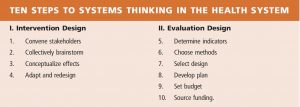
Details of these Ten steps to Systems Thinking in Health System are:
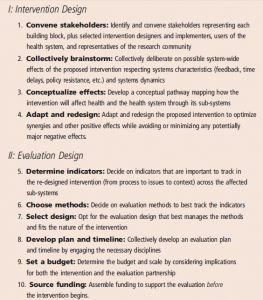
Limitations of ‘Systems Thinking’:
- Application of system thinking in which and every step require lots of time and money. One may not have the luxury of such time and money.
- It takes longer time to solve any issue with System Thinking concept.
- The concept of Systems Thinking in itself is very complex and difficult to turn into action.
- As Systems Thinking is about the bigger picture, often the interventions developed or the tools designed may turn out to be complex in itself.
Challenges for ‘Systems Thinking’ in Health System:
- Engaging ‘street level’ policy implementer or ‘street level bureaucrats’ at the design stage of new interventions
- Aligning priorities among multiple stakeholders
- Coordination with and among the partners
- Fulfilling and living up to the expectations of system stakeholders
- Building capacity at the country level
- Poor availability and quality of data
- Limited multi-disciplinary skills and weak collaborations in different sectors
How Can We Use ‘Systems Thinking’ for Health System Strengthening?
- Pulling the thinkers together
- Creating a community of practice
- Building leadership capacity
- Changing the curricula for public health schools
- Increasing people’s participation
- Increasing participation, ownership and engagement among the people working in different parts of the health system before we intervene and design and programs and policies
- Developing a network of institutions/individuals working together to increase the capacity and develop options for working in different scenarios.
References and for More Information:
Don de Savigny and Taghreed Adam (Eds). Systems thinking for health systems strengthening. Alliance for Health Policy and Systems Research, WHO, 2009.
https://www.saybrook.edu/blog/2011/06/22/evolution-systems-thinking/
http://citeseerx.ist.psu.edu/viewdoc/download?doi=10.1.1.418.2819&rep=rep1&type=pdf
http://learningforsustainability.net/systems-thinking/
https://managementhelp.org/misc/defn-systemsthinking.pdf
http://www.thwink.org/sustain/glossary/SystemsThinking.htm
http://environment-ecology.com/general-systems-theory/379-systems-thinking.html
https://searchcio.techtarget.com/definition/systems-thinking
https://health-policy-systems.biomedcentral.com/articles/10.1186/1478-4505-12-51
https://academic.oup.com/heapol/article/27/suppl_4/iv4/620794